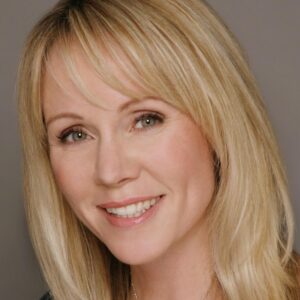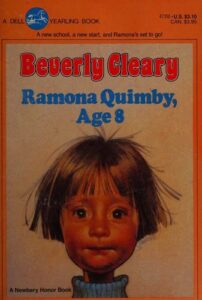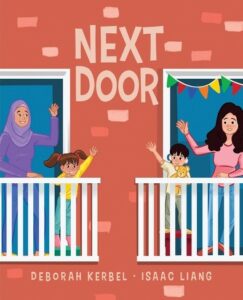 This month’s Author Interview is with Canadian writer Deborah Kerbel. To make her feel at home, I’ll be using the Canadian spellings throughout (colour, etc.). Fun, right?
This month’s Author Interview is with Canadian writer Deborah Kerbel. To make her feel at home, I’ll be using the Canadian spellings throughout (colour, etc.). Fun, right?
I first learned about her work via the graphic novel Fred & Marjorie, but since then I’ve sampled her MG novels, YA novels, and many picture books. She’s got a new picture book that just came out—Next Door (Kids Can Press)—and we’ll be sure to ask her about that in the interview. We’ll also talk about how she handles writing so many different types of stories.
To help us get a better sense of Deborah, here are 8 Fun Facts.
- My favourite books growing up were the Wizard of Oz series of books and anything by Beverly Cleary, Judy Blume, and Gordon Korman.
- My celebrity teen crush was Andrew Ridgeley from Wham! (if you’re thinking, who’s that? then you clearly weren’t around in the 80s).
- Before becoming a full-time author, I held an eclectic mix of jobs in fashion and music retail, telemarketing, restaurant hostessing, financial writing, and pajama modelling.
- My favourite foods are Pad Thai, Italian zucchini flowers, and lemon gelato.
- My #1 writing fuel? Strawberry Twizzlers.
- My biggest phobia is raw tomatoes (**shudder**).
- My go-to karaōke song is “Don’t Stop Believin”–in my dreams, I always hit that long, high note.
- My guiltiest reading pleasure…any book for “grown ups” makes me feel like I’m cheating on my towering TBR pile of kidlit books.
With a list like that, you practically don’t need anything more, right? Well, OPB is nothing if not thorough, so here’s an entire interview to make sure you know what makes Deborah as awesome as she is.
RVC: You can probably tell I’ve been binge-watching Marvel superhero movies because my first question is this—what’s your origin story as a writer?
DK: Growing up, books were a big deal in my house. My dad’s an author, too, so I suppose there’s a good amount of ink running through my veins. I was always reading something–it didn’t really matter what…comic books, novels, the back of cereal boxes. I just wanted to consume all the words I could get my eyes on. I always tell kids if you read enough books, eventually words and stories of your own will start spilling out. I guess that’s what happened to me.
RVC: That’s a story I hear a lot from the people I interview here.
DK: The first book I ever wrote was for a school project when I was 7 or 8 years old. (It was also the last book I ever attempted illustrate, but let’s not go there.) I love writing stories for young people and hopefully helping them to grow into lifelong readers.
RVC: What was the most important book of your childhood?
 DK: It’s SO hard to choose just one. But I’ll go with Ramona Quimby, Age 8 by Beverly Cleary. I even had the haircut to match!
DK: It’s SO hard to choose just one. But I’ll go with Ramona Quimby, Age 8 by Beverly Cleary. I even had the haircut to match!
RVC: Like you, I grew up in the 80s. What’s an 80s thing that deserves a comeback?
DK: With the Canadian winter fast approaching, I vote we bring back leg warmers. Cozy and très retro-cool!
RVC: Absolutely! Now, what career plan did you have when you attended Western University in London, Ontario?
DK: I had no career plan. I was really just winging it, taking courses that interested me while confident I’d figure it all out. Looking back now, I guess it shows I’ve always been a pantser, not a plotter. Plus, I’m an eternal optimist. Which is likely one of the reasons I’ve made it this far as a writer.
RVC: You write all kinds of things for kids. What are some of the challenges of writing such a wide range of stories?
DK: I suppose the biggest challenge is not having a literary “brand.” Readers aren’t always sure what to expect from me next. Probably because even I don’t know what I’ll do next! (See my previous answer about “pantser.”)
RVC: Picture books clearly hold a special place in your heart. Why?
DK: I love the collaborative nature of a picture book. I enjoy the challenge of writing a compelling story in so few words and pages. And I adore seeing the visual interpretation of a story that grew from my imagination. It’s such a special and unique creative process. And they’re so much fun to write!
RVC: Let’s help out the writers who follow OPB. What are some of the most common problems with picture book manuscripts.
DK: I think the #1 mistake is when I see writers prioritizing a message, moral, or a lesson before a good story. #2 mistake would be over-writing the text and not leaving enough space for an illustrator to join in with their vision.
RVC: And the secret to overcoming those is…?
DK: The secret to overcoming both is reading as many newly published picture books you can get your hands on, and thinking critically about the story and whether it speaks to you (or not) and why. Also, join a critique group of fellow picture book writers and be open to honest feedback.
RVC: If you had to summarize the most important thing you’ve learned about writing picture books, what would it be?
DK: All the same elements that are crucial to writing a good novel–plot, pacing, tension, character development, etc.–are just as important in a picture book.
RVC: What do you think is the most common misconception about picture books?
DK: That they’re easier to write than a novel. (Hint: they’re not!)
RVC: In your perspective, how different is the kidlit industry in Canada from that in the US?
DK: Well, for starters it’s much smaller. Everyone knows everyone in the Canadian kidlit world. Also, I’m not sure how it is in the US, but Canadian kidlit creators are incredibly supportive of each other. It’s like a warm and fuzzy maple-syrup flavoured family up here.
RVC: Sounds delicious! What role does your family play in your writing and revising process?
DK: My kids used to inspire my stories when they were little. They’re young adults now so, unfortunately, they offer a lot less picture book content for me to harvest. And my husband is my biggest cheerleader. He reads all my manuscripts before I send them out on submission and gives excellent (but honest) feedback.
RVC: Once COVID hit, I’ve tried to ask a question about self-care in every interview. What do you do to de-stress?
DK: A long walk with a good audiobook works for me every time.
 RVC: You’ve got a new picture book out. What’s the elevator pitch for Next Door?
RVC: You’ve got a new picture book out. What’s the elevator pitch for Next Door?
DK: Next Door is a wordless picture book about friendship, acceptance, breaking down barriers, and finding common ground, no matter our differences.
RVC: Where did the idea for this book come from?
DK: The main character in the book wears hearing aids and was inspired by my late sister, Kim, who was born profoundly deaf but had an easy way of making connections with people, regardless of speech or language barriers. The book is dedicated to her as well.
RVC: That sounds like a lovely way to honor your sister. Now, here’s the last question for this part of the interview. What should we expect from you next? What are you really looking forward to?
DK: I’ve got seven more books coming up the pipeline (one middle grade novel and six picture books), so this is a tricky one to answer. I’m excited for them all, but the one that comes to mind first is No Huddles for Heloise, a picture book an introverted penguin who cherishes alone time and personal space (kind of like me). It’s coming out in Winter 2025 with Orca Books.
RVC: Okay, Deborah. I know you’ve been thinking about this the entire time, and now it’s here—the SPEED ROUND! Wahoo! This means super-fast question followed by stunningly swift answers. Are you ready to meet the challenge?
DK: Let’s do it!
RVC: If you could only have one app on your phone, it’d be…
DK: Waze. (Wonky sense of direction here.)
RVC: Funniest word in the English language?
DK: Kerfuffle.
RVC: Guiltiest pleasure to order at Timmie’s?
DK: A sour cream donut.
RVC: What “old person” thing do you do?
DK: Fall asleep during movies.
RVC: Who sets the standard for picture book rhyme?
DK: Dr. Seuss.
RVC: Your picture book philosophy in five words or less.
DK: They can change the world.
RVC: Thanks so much, Deborah!


Great interview! Thanks!